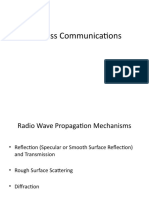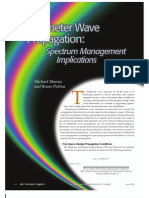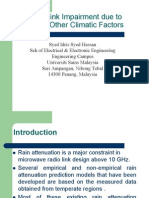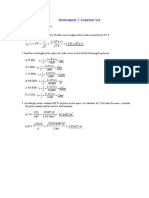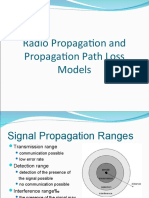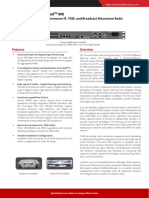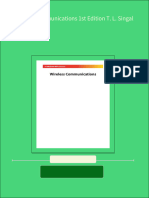Microwave Losses
Microwave Losses
Uploaded by
warren tupazCopyright:
Available Formats
Microwave Losses
Microwave Losses
Uploaded by
warren tupazOriginal Title
Copyright
Available Formats
Share this document
Did you find this document useful?
Is this content inappropriate?
Copyright:
Available Formats
Microwave Losses
Microwave Losses
Uploaded by
warren tupazCopyright:
Available Formats
MICROWAVE SIGNAL PROPAGATIONS
AND FACTORS AFFECTING SIGNAL
Module 3
1st Sem, S.Y. 2021-2022 ECE EL 11 – ECE ELECTIVE 1
PATH LOSS
As the signal propagates even using a directional LOS link’s beam antenna
experiences losses in transmission, referred as path loss. This is due to several
factors such as Free space path loss, atmospheric absorption and multipath
fading.
FREE SPACE PATH LOSS (FSL) The loss incurred by an electromagnetic wave as it
propagates in a straight line (LOS) through vacuum
with no absorption or reflection of the energy from
the nearby objects.
This is the effect of a signal spreading out as it
propagates from the transmitting antenna. This is
typically the greatest portion of path loss. Its effects
are directly proportional to the link’s distance and the
signal’s frequency—as either increases. This amount
of loss, expressed in dB
1st Sem, S.Y. 2021-2022 ECE EL 11
SAMPLE PROBLEM
Determine the free-space path loss for a microwave
system with a carrier frequency of 6 GHz and a
distance of 50 km
SOLUTION
𝐹𝑆𝐿 = 92.4 + 20 log 𝑑𝐾𝑚 + 20 log 𝑓𝐺𝐻𝑧
𝐹𝑆𝐿 = 92.4 + 20 log 50 + 20 log 6
𝐹𝑆𝐿 = 141.94 𝑑𝐵
1st Sem, S.Y. 2021-2022 ECE EL 11
SAMPLE PROBLEM
Determine the free space path loss between two
microwave antennas 38 km apart operating at 6450
MHz.
SOLUTION
𝐹𝑆𝐿 = 92.4 + 20 log 𝑑𝐾𝑚 + 20 log 𝑓𝐺𝐻𝑧
𝐹𝑆𝐿 = 92.4 + 20 log 38 + 20 log 6.45
𝐹𝑆𝐿 = 140.19 𝑑𝐵
1st Sem, S.Y. 2021-2022 ECE EL 11
PATH LOSS
ATMOSPHERIC ABSORPTION Atmospheric content and density varies significantly
with local geophysical characteristics and time of day
and season. The only thing one can say for sure is
that the atmosphere changes dynamically and is
never constant. Microwave signals energy attenuates
due to absorption of wave by atmospheric elements
such as oxygen and water vapor.
This effect is more noticeable as the link path distances increases. It also be
influenced by frequencies of operation.
• The attenuation due to oxygen is relatively constant in 2 to 14 GHz and
slightly under 0.01 dB/mile at 2 GHz and slightly above at the 14 GHz.
• Water vapor absorption is highly dependent on the frequency . It
extremely low at 2 GHz about 0.002 dB/mile and around 0.01 dB/mile
at 14GHz and 0.2 dB/mile at 20 GHz.
1st Sem, S.Y. 2021-2022 ECE EL 11
OXYGEN ABSORPTION LOSS
OXYGEN ABSORPTION LOSS Attenuation due to the absorption of radio
frequency energy by oxygen molecules.
For frequencies below 57 GHz
6.09 4.81
𝐴𝑜 = 7.19𝑥10−3 + 2 + 2 𝑥𝑓 2 𝑥10−3 𝑑𝐵/𝐾𝑚
𝑓 + 0.227 𝑓 − 57 + 1.5
For frequencies below 57 GHz and 63 GHz
0.265 0.028
𝐴𝑜 = 3.79𝑥10−7 + 2 + 2 𝑥 𝑓 + 198 2 𝑥10−3 𝑑𝐵/𝐾𝑚
𝑓 − 57 + 1.59 𝑓 − 118 + 1.47
Frequency 𝑓 in GHz.
1st Sem, S.Y. 2021-2022 ECE EL 11
SAMPLE PROBLEM
Compute the oxygen absorption loss for path length of 30 km with a microwave
system operating at the frequency of : a. 12.82 GHz, and b. 13.08 GHz.
6.09 4.81
a. 12.82 GHz 𝐴𝑜 = 7.19𝑥10−3 + 2 + 2 𝑥𝑓 2 𝑥10−3𝑑𝐵/𝐾𝑚
𝑓 + 0.227 𝑓 − 57 + 1.5
6.09 4.81
𝐴𝑜 = 7.19𝑥10−3 + + 𝑥 12.82 2 𝑥10−3 = 𝟕. 𝟔𝟕𝒙𝟏𝟎−𝟑 𝑑𝐵/𝐾𝑚
12.82 2 + 0.227 12.82 − 57 2 + 1.5
𝐴𝑜 for 30 km = 7.67𝑥10−3 dB/km x 30km = 𝟎. 𝟐𝟑 𝐝𝐁
b. 13.08 GHz 6.09 4.81
𝐴𝑜 = 7.19𝑥10−3 + 2 + 2 𝑥𝑓 2 𝑥10−3 𝑑𝐵/𝐾𝑚
𝑓 + 0.227 𝑓 − 57 + 1.5
6.09 4.81
𝐴𝑜 = 7.19𝑥10−3 + + 𝑥 13.08 2 𝑥10−3𝑑𝐵/𝐾𝑚
13.08 2 + 0.227 13.08 − 57 2 + 1.5
𝐴𝑜 for 30 km = 7.738𝑥10−3 dB/km x 30km = 𝟎. 𝟐𝟑𝟐 𝐝𝐁
1st Sem, S.Y. 2021-2022 ECE EL 11
WATER VAPOR LOSS
WATER VAPOR LOSS Attenuation due to the absorption of radio frequency
energy by water vapour in the atmosphere.
3 9 4.3
𝐴𝐻2 𝑂 = 0.067 + 2
+ 2
+ 2
𝑥𝑓 2 𝑥 𝛼 𝑥10−4 𝑑𝐵/𝐾𝑚
𝑓 − 22.3 + 7.3 𝑓 − 183.3 +6 𝑓 − 323.8 + 10
𝑓 in GHz
𝛼 is water vapour density in gm/m3, should be below 12 gm/m3
This formula applies for the frequencies below 350 GHz
1st Sem, S.Y. 2021-2022 ECE EL 11
SAMPLE PROBLEM
Compute the water vapour loss for path length of 30 km with a microwave
system operating at the frequency of : a. 12.82 GHz, and b. 13.08 GHz.
a. 12.82 GHz
3 9 4.3
𝐴𝐻2 𝑂 = 0.067 + 2
+ 2
+ 2
𝑥𝑓 2 𝑥 𝛼 𝑥10−4 𝑑𝐵/𝐾𝑚
𝑓 − 22.3 + 7.3 𝑓 − 183.3 +6 𝑓 − 323.8 + 10
3 9 4.3
𝐴𝐻2 𝑂 = 0.067 + 2 + 7.3
+ + 𝑥 12.82 2 𝑥 12 𝑥10−4
12.82 − 22.3 12.82 − 183.3 2 + 6 12.82 − 323.8 2 + 10
= 𝟎. 𝟎𝟏𝟗𝟒 𝒅𝑩/𝑲𝒎
𝑑𝐵
𝐴𝐻2 𝑂 𝑓𝑜𝑟 30 𝐾𝑚 = 0.0194 𝑥 30 𝑘𝑚 = 𝟎. 𝟓𝟖𝟐 𝐝𝐁
𝐾𝑚
b. 13.08 GHz
3 9 4.3
𝐴𝐻2 𝑂 = 0.067 + 2
+ + 𝑥 13.08 2 𝑥 12 𝑥10−4
13.08 − 22.3 + 7.3 13.08 − 183.3 2 + 6 13.08 − 323.8 2 + 10
= 𝟎. 𝟎𝟐𝟎𝟓 𝒅𝑩/𝑲𝒎
𝑑𝐵
𝐴𝐻2 𝑂 𝑓𝑜𝑟 30 𝐾𝑚 = 0.0205 𝑥 30 𝑘𝑚 = 𝟎. 𝟔𝟏𝟓 𝐝𝐁
𝐾𝑚
1st Sem, S.Y. 2021-2022 ECE EL 11
MULTIPATH FADING
MULTIPATH FADING The path propagation that must be taken into account in the
design of terrestrial LoS links can be divided into two
groups depending on the presence, or not, of their effect
on outage.
When signals arrive at a remote antenna after being reflected off the ground or
refracted back to earth from the sky, they will subtract (or add) to the main signal and
cause the received signal to be weaker (or stronger) throughout the day. Thus, the
major sources of multipath propagation are reflection and refraction.
Multipath fading is the major outage
causing mechanism below about 10
GHz on links longer than a few
kilometres
Space Diversity Radio
Configuration is used to Counter Image from: MICROWAVE COMMUNICATION BASICS: THE THEORY, PRACTICES
AND TECHNOLOGIES THAT LINK THE WIRELESS WORLD.
Multipath Fading https://www.commscope.com/resources/eBooks/
1st Sem, S.Y. 2021-2022 ECE EL 11
MULTIPATH FADING
REFLECTION The returning or throwing back of microwave signals by a reflective
surface upon which the radiation is incident.
Reflection always assumed to be caused by the reflective points
along terrain, but reflection point may occur after link has been
installed due to development under the path.
Bodies of water along the path may not necessarily cause multipath fading, as long as
conditions of reflector can be avoided.
1st Sem, S.Y. 2021-2022 ECE EL 11
MULTIPATH FADING
The path survey report is a very important part of the microwave system engineering,
and is prepared by the field engineer who carefully verifies and documents antenna
coordinates, path obstacles, terrain topology, and surface characteristics. The resulting
report provides crucial information that is required by the system engineer in order to
perform reflection, link, and reliability analysis of the system design
Points to be considered as reflective are bodies of water,
POINT OF
marshlands, swamps, rice fields, flat terrain, peaks and snow or
REFLECTION
ice.
The reflected signal is 180 degrees out of phase
with respect to any direct path signal that has not 𝜃𝑖 𝜃𝑟
been reflected. The nature of point-to-point
terrestrial line-of-sight microwave systems causes Do not compute reflective surfaces which are
most reflected signals to occur at small angles, already hidden (covered) by obstructions along the
primarily due to the high ratio of path length path. Urban areas and timberlands may create
versus antenna height above a specific reflection reflections points but they have tendency to diffuse
point. any multipath propagations.
1st Sem, S.Y. 2021-2022 ECE EL 11
MULTIPATH FADING
REFRACTION Occurs when a RF signal is being bent. This typically can happen
as the RF signal passes through a path with a different density,
thus causing the direction of the wave to change.
A refraction can typically appear when dealing with long-distance
as the index of refraction may not even be constant along the path
Refraction fundamentally consists of 2 effects on the EM waves: (a)
the changing of the angle of incidence when travelling between 2
bodies of different density, (b) the reduction or increase of velocity
of propagation
Some Causes are: (a) Water vapor, (b)Changes in air temperature
, and (c) Changes in air pressure.
1st Sem, S.Y. 2021-2022 ECE EL 11
MULTIPATH FADING
REFRACTION Refraction is measured based on the k-factor. To compensate for
difficult terrain inconsistent refractivity (atmospheric changes along
the path), k factor value may be adjusted to consider more adverse
conditions
The mean sea level (MSL) is much
higher than that of the mountain
top, known as the atmospheric
gradient.
This may results a lower data rates,
re-transmissions and lead to
reduced capacity.
Image from: https://dot11ap.wordpress.com/cwna/radio-
frequency-rf-technologies/reflection-refraction-diffraction-and-
scattering/
1st Sem, S.Y. 2021-2022 ECE EL 11
MULTIPATH FADING
Also, the time of day also creates variances in the index of refraction of the
atmosphere in a given place.
DUCTING AND THERMAL INVERSION Ducts can be formed during temperature
inversion in very stable conditions. Trapped
waves bounce back and forth in a duct
caused by temperature and humidity
inversion, and insert sources of multipath
interference.
In cases like sand (or desert), the extremes
of temperature during night and day almost
always causes atmospheric ducts to be
created.
1st Sem, S.Y. 2021-2022 ECE EL 11
MULTIPATH FADING
DUCTING AND Multipath propagation due of elevated ducts are:
THERMAL INVERSION a. Duct Reflected – This condition happens when an elevated
duct, either below or above the path, causes the side lobes or
main lobe to bounce off the surface of the duct and target the
receiving antenna.
b. Duct Refracted – When elevated ducts, either below or
above the path accepts then bends or propagates slightly the
signal from a sidelobe or main lobe then sends the signal to
the receiving antenna.
c. Duct Trapped – a combination of both refraction and
reflection. Rare but does occur, the spurious signal trapped
between a lower duct then exits the duct at the receiving end.
d. Duct Propagated – is the condition when the duct contains
both the transmitting and receiving antenna. These
atmospheric ducts are not permanent and occur only for
several minutes at a time.
1st Sem, S.Y. 2021-2022 ECE EL 11
OTHER TYPES FADING
Due to Atmospheric anomalies different frequencies undergo
FREQUENCY
different attenuation levels. Frequency Diversity Radio
SELECTIVE FADING Configuration is used to Counter Frequency Selective Fading
Any form of precipitation in the atmosphere such what occurs
RAIN FADING
in the clouds to form rain can, causes attenuation of signal
received due to refraction. Precipitation attenuation is the major
outage causing mechanism above 10 GHz, rain attenuation
depends upon the rate of rainfall, size of the drops and the
length of exposure. Heavy rain has a particularly destructive
effect on higher-frequency links, because the size of a typical
raindrop more closely approximates the size of the signal’s
wavelength, creating a formidable attenuating obstacle.
Path Diversity / Route Diversity is the only counter measure for
Rain Fade
1st Sem, S.Y. 2021-2022 ECE EL 11
RAIN FADING
Influence of rain and fog at high frequencies. At microwave low
RAIN LOSS/
frequency, rain attenuation as such is not consideration in the design of
RAIN FADING
path except in very extreme condition.
Rain has a predominantly unfavorable
effect on higher-frequency links. This brings
us back to the issue of frequency and the
role it plays in link performance and
reliability. Related with technology, there
are tradeoffs to consider with each option.
Higher frequency bands offer greater
capacity but reduced reliability.
Frequencies above 10 GHz can be
attenuated by rain principally heavy rain
Image from: https://www.epfl.ch/labs/lte/research/past-
because the size of a typical raindrop more research/page-50160-en-html/
closely approximates the size of the
signal’s wavelength, creating a formidable In areas of heavy rainfall where extremely high reliability
attenuating obstacle is required, short wave path are recommended.
1st Sem, S.Y. 2021-2022 ECE EL 11
RAIN FADING
EFFECT OF RAIN DROPS ON RADIO FREQUENCIES
• Refraction. Radio wave gets refracted (changed in direction) where
each frequencies refracts in different angle.
• Scattering of Diffusion. In this condition, causing the main lobe to
be enlarge at the point where the rain exists. This is also true only
when the wavelength of the frequency used is much larger than the
rain drop size.
• Repropagation. When the wavelength is much smaller than the
raindrop, and gravitation causes the raindrop to distort into oval
shape, each drop would then act like a tiny dipole, receiving the
radiowave and radiating isotropically. This also causes the drop to
heat up.
1st Sem, S.Y. 2021-2022 ECE EL 11
RAIN ATTENUATION
RAIN There are fundamentally 2 methods to compute for the attenuation
ATTENUATION due to the effects of rain: the CRANE and CIRR Rec. 530 method.
The use of the Crane Rain Attenuation is only effective on path
lengths upto about 22.5 km, greater distances than this, the CCIR
recc 530 method is used
REGRESSION CEFFICIENT
TABLE. Compute the values
of K and α depend on the
polarization and based on
both duplex transmit
frequencies selected.
Image from: Rule, Manuel T. ,
Fundamentals on Microwave
Communication with Microwave
Planning Guide, (2000)
1st Sem, S.Y. 2021-2022 ECE EL 11
RAIN ATTENUATION
REGRESSION COEFFICIENT Compute the interpolated values of the regression
coefficient for both transmit frequencies:
𝐿𝑜𝑔10 𝑓1 − 𝐿𝑜𝑔10 𝑓𝑥
𝑀=
𝐿𝑜𝑔10 𝑓1 − 𝐿𝑜𝑔10 𝑓2
𝑘𝑥 = 𝐿𝑜𝑔10 −1 𝐿𝑜𝑔10 𝑘1 − 𝑀𝑥 𝐿𝑜𝑔10 𝑘1 − 𝐿𝑜𝑔10 𝑘2
𝛼𝑥 = 𝛼1 − 𝑀𝑥(𝛼1 -𝛼2 )
NOTE: Interpolation formula used:
𝑓1 < 𝑓𝑥 < 𝑓2 𝑘1 < 𝑘𝑥 < 𝑘2 α1 < α𝑥 < α2
Horizontally polarized signals are more prone to rain due to the shape of the falling
raindrops, thus vertical polarization the better for microwave link planning.
1st Sem, S.Y. 2021-2022 ECE EL 11
RAIN ATTENUATION
CRANE RAIN ATTENUATION METHOD
1st Sem, S.Y. 2021-2022 ECE EL 11
RAIN ATTENUATION
CRANE RAIN ATTENUATION METHOD Use of this method is only effective on path
lengths up to about 22.5 km
𝑑 = (3.8 − 0.6 )𝑥 Ln(𝑅𝑝 ) where: 𝑅𝑃 is the crane rainfall rate taken from the table.
𝐿𝑛(𝑏𝑥𝑒 𝑐𝑑 )
𝑏 = 2.3 𝑥𝑅𝑃 −0.17 𝑐 = 0.026 − 0.03𝑥𝐿𝑛(𝑅𝑝 ) µ=
𝑑
For conditions that the path length, 𝐷 in km is less than 𝑑:
𝛼𝑥 𝑒 𝜇𝛼𝑥 𝐷 − 1 where: 𝐴𝑅 is the rain attenuation in dB
𝐴𝑅 = 𝑘𝑥 𝑥𝑅𝑝 𝑥
µ 𝑥 𝛼𝑥 𝐷 is the path length in km.
For conditions that path length is greater or equal to 𝑑 but shorter than or equal to 22.5 km
𝛼𝑥 𝑒 𝜇𝛼𝑥 𝑑 − 1 𝑏 𝑐𝛼𝑥 𝑥𝑒 𝜇𝛼𝑥 𝑑 𝑏 𝑐𝛼𝑥 𝑥𝑒 𝜇𝛼𝑥 𝐷
𝐴𝑅 = 𝑘𝑋 𝑥𝑅𝑃 − −
µ 𝑥 𝛼𝑥 𝑐 𝑥 𝛼𝑥 𝑐 𝑥 𝛼𝑥
1st Sem, S.Y. 2021-2022 ECE EL 11
RAIN ATTENUATION
CCIR Critical Rainfall Attenuation If the path length is greater than 22.5 km, the CCIR recc
530 method is used.
Rainfall intensity exceed in mm/h
Percentage A B C D E F G H J K L M N P
of Time
1.000% 0.5 1 2 3 1 2 3 2 8 2 2 4 5 12
0.300% 1 2 3 5 3 4 7 4 13 6 7 11 15 34
0.100% 2 3 5 8 6 8 12 10 20 12 15 22 35 65
0.030% 5 6 9 13 12 15 20 18 28 23 33 40 65 105
0.010% 8 12 15 19 22 28 30 32 35 42 60 63 95 14
0.003% 14 21 26 29 41 54 45 55 45 70 105 95 140 200
0.001% 22 32 42 42 70 78 65 83 55 100 150 120 180 250
NOTE: • Not all letters appear on the Asia-Pacific climatic zone map. Refer for the world wide CCIR rainfall rate distribution.
• For design considerations unavailability is usually set to 0.01% as industry standard availability has a minimum value
of 99.99% or design consideration above 99.999% used unavailability of 0.001% (designated as 𝑅0.001 )
1st Sem, S.Y. 2021-2022 ECE EL 11
RAIN ATTENUATION
RECOMMENDATION ITU-R PN.837-1
CHARACTERISTICS OF PRECIPITATION
FOR PROPAGATION MODELLING
In Climatic table, rainfall rate for the
Philippines (in Luzon) is in area N
or 180 mm/hr at an unavailability of
0.001%
1st Sem, S.Y. 2021-2022 ECE EL 11
RAIN ATTENUATION
In calculating the CCIR critical rainfall attenuation, first determine from the climatic zone
table the rainfall rate based on the location and design availability
Effective Rain Path length. DE:
−0.015 𝑅
𝐷𝑂 = 35𝑒 mm
where: 𝑅= Rainfall rate, ( ) for specific unavailability
hr
D
𝐷𝐸 = 𝐷𝐸 = effective rain path length
D
1+
Do
mm
Rain unit attenuation, 𝛾: where: 𝑹= Rainfall rate, ( ) for specific unavailability
hr
𝑘𝑋 and 𝛼𝑥 = the regression coefficient for specific operating
𝛾 = 𝑘𝑋 𝑥𝑅 𝛼𝑥 frequencies
Path Rain Attenuation, 𝐴𝑅: is the product of effective rain path length and rain unit
attenuation
𝐴𝑅 = (𝐷𝐸)(𝑌)
1st Sem, S.Y. 2021-2022 ECE EL 11
Other Factors that affects Microwave
Signal
DIFFRACTION Is the bending and spreading around of an RF signal when it encounters
an obstruction. The waves that encounter the object bend around the
object, taking a longer and different path. However, waves that do not
encounter the object do not bend and maintain a shorter and original path.
Diffraction is caused by some sort of partial
blockage such as a small hill or building that
is between a transmitting radio and receiver.
An another approach to supplement clear LOS
design methods is to work with the use of
diffraction to allow non line-of-sight (NLOS)
links. These non-LOS links use natural
diffraction propagation properties that scatter
the radio signal around a blocking obstacle,
thus allowing the transmission signal energy
Image Source:
http://spot.pcc.edu/~wlara/eet223/slides/Chapter13.pdf
into the shadow.
1st Sem, S.Y. 2021-2022 ECE EL 11
Other Factors that affects Microwave
Signal
DIFFRACTION If diffraction could be anticipated with an improved system reliability,
it could be used to design and build wireless backhaul links in
challenging environments, thus, reducing the need to build
repeaters and making more efficient network design.
This increases the path loss onto the radio path loss predictions, that of
diffraction loss.
Image Source:
https://research.fb.com/blog/2021/01/accel
erating-rural-connectivity-research-how-
facebook-helps-bring-connectivity-to-hard-
to-reach-areas/
1st Sem, S.Y. 2021-2022 ECE EL 11
Other Factors that affects Microwave
Signal
KNIFE –EDGE where:
C - height of the top of the
DIFFRACTION obstacle with respect to straight
line joining the two ends of the
path (or LOS) path. If the height is
below the path, C is negative. If
goes above the line of site path, C
positive.
d1 and d2 : distances of the two
ends of the path from the top of
the obstacle or the vertex
D : length of the path
𝜃: angle of diffraction (rad); its
sign is the same as that of C.
𝛼1 and 𝛼2 : angles in radians
between the top of the obstacle
and one end as seen from the
other end
1st Sem, S.Y. 2021-2022 ECE EL 11
Other Factors that affects Microwave
Signal
SINGLE KNIFE –EDGE Compute the height C ( clearance) over the first Fresnel
DIFFRACTION LOSS using the larger Fresnel radii from a lower of the 2 duplex
frequency.
𝐶(𝑚) 𝐹𝐺𝐻𝑧 𝐷𝑘𝑚
= NOTE: C is negative, if the obstruction lines below the path and
𝐹1(𝑚) 𝑑1(𝑘𝑚) 𝑑2(𝑘𝑚) C is positive, if the obstruction goes over the LOS path.
The solve for V: (this Using the Freznel-Kirchoff formula, solve the attenuation of
formula at 60% clearance) single knife edge obstruction along the path
𝑓𝑜𝑟 𝑉 < −0.8 𝑓𝑜𝑟 − 0.8 ≤ 𝑉 ≤ 0
𝐶
𝑉= 2 = 0 𝑑𝐵 A V, 0 = 6.02 + 9.0𝑉 + 1.65𝑉 2 𝑑𝐵
𝐹1
𝑓𝑜𝑟 0 ≤ 𝑉 ≤ 2.4
A V, 0 = 6.02 + 9.11𝑉 + 1.27𝑉 2 𝑑𝐵
Where 𝐴 𝑉, 0 is
𝑓𝑜𝑟 2.4 ≤ V
the diffraction loss
A V, 0 = 12.953 + 20𝑙𝑜𝑔𝑉 𝑑𝐵
1st Sem, S.Y. 2021-2022 ECE EL 11
Other Factors that affects Microwave
Signal
Other diffraction calculation model are:
• Single Isolated Obstacle
• Double Knife Edge Diffraction/Multiple Knife Edge Diffraction
• Epstein-Peterson Diffraction Calculation
• Deygout Diffraction Calculation
• Longley-Reasoner Formula LOS Model
CLUTTER LOSS It is described as attenuation due to trees and building in the
front of the antenna. They have same clearing factor as
diffraction, 150% of the first Fresnel zone, and they should be
within the near field of the antenna. This is to be added to
diffraction losses.
Three considerations how trees, forest and thick foliage effect the transmission of the
microwave link: (a) Attenuation though trees, (b) lateral wave propagation along the tree
tops, and (c) knife edge diffraction over the tree tops.
1st Sem, S.Y. 2021-2022 ECE EL 11
Other Factors that affects Microwave
Signal
INTERFERENCE In general, any kind of radiation disturbance on the radio link
systems like those radiation from other radio systems.
Subdivided into 2 classes:
• Noise – is the when unwanted signal of the same nature as carrier or baseband enter
the system.
• Distortion – is when the signal itself undergoes changes as it passes through blocks in
the system
The license applicant must identify if the designed
COLLOCATION point to point system will experience or may cause
Collocation, also known as co-siting, is a interference in the existing environment. Thus this
common concept of multistation sites calculations will indicate whether there is a need for a
containing numerous transmitters and redesign or relocation of the planned systems. RF
receivers installed within a limited
geographical area. The site often contains
interference occur in collocated systems and
number of antennas that are all mounted on additionally complicates interference analysis and
the same tower or distributed among a small control.
number of closely placed towers.
1st Sem, S.Y. 2021-2022 ECE EL 11
Other Factors that affects Microwave
Signal
COLLOCATION
Image from: https://turbofuture.com/industrial/Microwave-Radio-Communications
1st Sem, S.Y. 2021-2022 ECE EL 11
Other Factors that affects Microwave
Signal
Near interference, also known as on-site interference. Refers to interference
influences arising from transmitters in one site and receivers situated at the same site
(collocation) or in its immediate vicinity.
For collocated system of antenna sharing towers, interference can occur under several
conditions:
Adjacent Channel Interference – when carrier frequency of 2 adjacent link belong to
same band. If poor selectivity, the receiver may demodulate both signals which results
baseband distortion.
Solutions to adjacent interference:
(a) careful planning on the high band
assignment. This would place a high and low
band link on each antenna, thus increase the
separation of the receive antenna.
(b) Coding the baseband before transmission
for signal isolation,
(c) Selecting of farther channel plan without
changing component in the system
1st Sem, S.Y. 2021-2022 ECE EL 11
Other Factors that affects Microwave
Signal
Front to Back Coupling– For
links which are cascaded or
linear, this is when the back lobe
from antenna of one link get
coupled with the either the main
lobe, side lobe or back lobe of
another antenna on the same
tower.
Solutions to adjacent interference:
(a)Careful planning of high band assignment
(b) Moving one or both antenna on the tower which interference occurs
(c) Placing shroud on the antenna or a grounded mesh between antennas
(d) Changing channel plan in one link
1st Sem, S.Y. 2021-2022 ECE EL 11
Other Factors that affects Microwave
Signal
Overshoot– This is when the power used is high enough that it interferes with the far
end another link. Solution id to lower the power output of the interfering link
1st Sem, S.Y. 2021-2022 ECE EL 11
Other Factors that affects Microwave
Signal
Far interference known as far-field interference is existing when a received signal is
disturbed by signals that are sent either on the same channel (co-channel interference)
or an adjacent channel (adjacent-channel interference) produced by a transmitter
located far away from the receiver
Far interference is often the main reason
regards the limit of the number of paths
that can be set up within a given
geographical area.
Most common path related interference is
Cross Polarization, when the main lobes of
2 links having same band of frequencies
intersect causing the information from one
link to jump to other, resulting to amplitude
and phase distortion on both links
1st Sem, S.Y. 2021-2022 ECE EL 11
REFERENCES
Book(s):
• Tomasi, Wayne. Advanced Electronic Communications Systems, 6th ed., (2014)
• Blake, Roy. Electronic Communication Systems, 2nd ed., (2008)
• Lephamer, Harvey. Microwave Transmission Network: Planning, Designing and Deployment,
2nd Ed., (2010)
• Rule, Manuel T. , Fundamentals on Microwave Communication with Microwave Planning
Guide, (2000)
Other Materials:
• MICROWAVE COMMUNICATION BASICS: THE THEORY, PRACTICES AND
TECHNOLOGIES THAT LINK THE WIRELESS WORLD.
https://www.commscope.com/resources/eBooks/
• https://dot11ap.wordpress.com/cwna/radio-frequency-rf-technologies/reflection-refraction-
diffraction-and-scattering/
• https://www.itu.int/dms_pubrec/itu-r/rec/p/R-REC-P.526-14-201801-I!!PDF-E.pdf
1st Sem, S.Y. 2021-2022 ECE EL 11
You might also like
- Wireless Communication Networks and Systems 1st Edition Beard Solutions ManualDocument11 pagesWireless Communication Networks and Systems 1st Edition Beard Solutions ManualHasnin shah0% (1)
- Principles of Modern Radar Answers To Selected ProblemsDocument6 pagesPrinciples of Modern Radar Answers To Selected Problemsrisovi100% (1)
- Microwave RadioDocument58 pagesMicrowave Radiowarren tupazNo ratings yet
- Chapter 7 SolutionsDocument21 pagesChapter 7 SolutionsARSYIAN RIZKI PRATAMANo ratings yet
- Rafael Mellafe - La Supuesta Ayuda Inglesa A ChileDocument24 pagesRafael Mellafe - La Supuesta Ayuda Inglesa A ChileFrancisco Betancourt Castillo100% (1)
- Implementation Notes: 2.1. Link CalculationDocument8 pagesImplementation Notes: 2.1. Link CalculationpanjeduNo ratings yet
- CHAPTER 2.finaleDocument27 pagesCHAPTER 2.finaleapi-19731397No ratings yet
- Wireless Issue Part 2Document4 pagesWireless Issue Part 2nomatters_evenNo ratings yet
- Jimma Institute of Technology Fuculty of Electrical and Computer Engineering Communication Engineering MSC ProgramDocument6 pagesJimma Institute of Technology Fuculty of Electrical and Computer Engineering Communication Engineering MSC ProgramEyasu Kanbato OtoroNo ratings yet
- ECE8863-Lecture5 - Characterizations Part1Document38 pagesECE8863-Lecture5 - Characterizations Part1Soufiane KarrakchouNo ratings yet
- CSE30331 2023-24 - LabDocument11 pagesCSE30331 2023-24 - Lab1214135360No ratings yet
- Fiber Optics Communications SystemDocument73 pagesFiber Optics Communications SystemKim Brian CarboNo ratings yet
- Microwave ProjDocument10 pagesMicrowave ProjEarl NigelNo ratings yet
- Uo 876 KfvuiteyhrtyhryujyujuDocument84 pagesUo 876 KfvuiteyhrtyhryujyujurubbbitsNo ratings yet
- Old QADocument53 pagesOld QAjohn8880No ratings yet
- 13 - Tutorial of Chapter 3 PDFDocument16 pages13 - Tutorial of Chapter 3 PDFWaqas Ahmed0% (1)
- Wireless CommunicationsDocument76 pagesWireless CommunicationsCeren çelikNo ratings yet
- Wideband Dual Posts Waveguide Band Pass FilterDocument7 pagesWideband Dual Posts Waveguide Band Pass FilterAmador Garcia IIINo ratings yet
- Sulic - SerbiaDocument14 pagesSulic - SerbiaДрагослав БјелицаNo ratings yet
- FPC ProblemSet1 2011-10-26 SolutionDocument2 pagesFPC ProblemSet1 2011-10-26 SolutionBernard Narh100% (2)
- ECE331 HW2 SolnDocument16 pagesECE331 HW2 SolnDean WinchesterNo ratings yet
- Anas GhawanmehDocument24 pagesAnas GhawanmehSaba GheniNo ratings yet
- Propagation ManagementDocument9 pagesPropagation ManagementChrispin MulandNo ratings yet
- Jimma Institute of Technology Fuculty of Electrical and Computer Engineering Communication Engineering MSC Progra1Document7 pagesJimma Institute of Technology Fuculty of Electrical and Computer Engineering Communication Engineering MSC Progra1Eyasu Kanbato OtoroNo ratings yet
- Chp2-Planar Transmission LineswithexamplesDocument56 pagesChp2-Planar Transmission LineswithexamplesdhruvaaaaaNo ratings yet
- 6 Dyed CsawgDocument34 pages6 Dyed CsawgDexter U. AzarconNo ratings yet
- Properties of Light: T E 15 MJ N 5.24Document17 pagesProperties of Light: T E 15 MJ N 5.24077 AgentNo ratings yet
- Homework Chapter 02Document8 pagesHomework Chapter 02Muzamil ShahNo ratings yet
- ESP Principle and DesignDocument30 pagesESP Principle and Designankurkatkar26No ratings yet
- Measurement of Advanced Electromagnetic Radiation 2Document7 pagesMeasurement of Advanced Electromagnetic Radiation 2Michael AbramsonNo ratings yet
- Tutorial Set 1Document2 pagesTutorial Set 1elisee tsokezoNo ratings yet
- PSPM SP025 CH 8Document4 pagesPSPM SP025 CH 8CHEW LI QI MoeNo ratings yet
- N - 1431 - PHY Practical2Document7 pagesN - 1431 - PHY Practical2Swarup DevdeNo ratings yet
- COMWIRLDocument37 pagesCOMWIRLJohn Benedict CarbonelNo ratings yet
- Assignment - 05 Chapter-07Document10 pagesAssignment - 05 Chapter-07Sadia Islam ShefaNo ratings yet
- Assignment 2 - FOCDocument12 pagesAssignment 2 - FOCChandan GurnaniNo ratings yet
- Homework 5Document5 pagesHomework 5Wayne Jude BertumenNo ratings yet
- Quantum Transport in in Ga As Quantum Wires: PhysicsDocument3 pagesQuantum Transport in in Ga As Quantum Wires: PhysicsRajdeep BanerjeeNo ratings yet
- 119A2032 Krishnaveni Doki MCS Exp5Document8 pages119A2032 Krishnaveni Doki MCS Exp5Ishika DokiNo ratings yet
- Hall MobilityDocument27 pagesHall MobilityTushar Dhabal DasNo ratings yet
- Multi-Layer Fiber For Dispersion Compensating and Wide Band AmplificationDocument6 pagesMulti-Layer Fiber For Dispersion Compensating and Wide Band AmplificationUbiquitous Computing and Communication JournalNo ratings yet
- Mwe 18u01030Document15 pagesMwe 18u01030SANDA ADITYA VARDHANNo ratings yet
- c2Document16 pagesc2farouq_razzaz2574No ratings yet
- Scaps Simulation of Zno/In S /cu SN S /mo Solar Cell: Phung Dinh Hoat, Do Phuc HaiDocument7 pagesScaps Simulation of Zno/In S /cu SN S /mo Solar Cell: Phung Dinh Hoat, Do Phuc HaiLong HoàngNo ratings yet
- EE138 Chapter 2 - SlidesDocument18 pagesEE138 Chapter 2 - SlidesWenhaoShiNo ratings yet
- EE138 Chapter 2 - Slides - Annotated 10-13Document18 pagesEE138 Chapter 2 - Slides - Annotated 10-13WenhaoShiNo ratings yet
- Experimental Analysis of Digital Losses in Optical Fiber Communication SystemDocument8 pagesExperimental Analysis of Digital Losses in Optical Fiber Communication SystemMohamed Aly SowNo ratings yet
- Radio Propagation and Propagation Path Loss ModelsDocument42 pagesRadio Propagation and Propagation Path Loss ModelsNoshin FaiyroozNo ratings yet
- Device Simulation of SB S Solar Cells by SCAPS-1D Software: ODARI, Victor, MUSEMBI, Robinson and MWABORA JuliusDocument16 pagesDevice Simulation of SB S Solar Cells by SCAPS-1D Software: ODARI, Victor, MUSEMBI, Robinson and MWABORA JuliusHadeer AbdelazizNo ratings yet
- Cable Fault Location in Power Cables PDFDocument19 pagesCable Fault Location in Power Cables PDFkokonut1128No ratings yet
- ET4254 Communications and Networking 1 - Tutorial Sheet 3 Short QuestionsDocument5 pagesET4254 Communications and Networking 1 - Tutorial Sheet 3 Short QuestionsMichael LeungNo ratings yet
- Subm To:Tewodros .M SUBM DATE: 5/9/2024Document11 pagesSubm To:Tewodros .M SUBM DATE: 5/9/2024danitemesgen954No ratings yet
- Electrostatic PrecipitatorDocument12 pagesElectrostatic PrecipitatorrajeshNo ratings yet
- (MWRF0012) Simplified Method Eases The Design of Bandpass FiltersDocument4 pages(MWRF0012) Simplified Method Eases The Design of Bandpass Filtersagmnm1962100% (1)
- Exercices Opt 2 WBC 14 011 2021Document29 pagesExercices Opt 2 WBC 14 011 2021Ikram ZineNo ratings yet
- Filter Design PDFDocument11 pagesFilter Design PDFarunkr1No ratings yet
- Under Water Optical CommunicationDocument49 pagesUnder Water Optical CommunicationAnurag Palakurthi100% (1)
- Goldsmith SolutionsDocument86 pagesGoldsmith SolutionsDemissew W. Kessela67% (3)
- Modern Devices: The Simple Physics of Sophisticated TechnologyFrom EverandModern Devices: The Simple Physics of Sophisticated TechnologyNo ratings yet
- Ece 10 - Microprocessor and Microcontroller System and Design (Module 3)Document31 pagesEce 10 - Microprocessor and Microcontroller System and Design (Module 3)warren tupazNo ratings yet
- Ece 10 - Microprocessor and Microcontroller System and Design (Module 1)Document20 pagesEce 10 - Microprocessor and Microcontroller System and Design (Module 1)warren tupazNo ratings yet
- Transcend 800: High Performance IP, TDM, and Broadcast Microwave RadioDocument4 pagesTranscend 800: High Performance IP, TDM, and Broadcast Microwave Radiowarren tupazNo ratings yet
- Alcatel-Lucent 9500 MXC: Microwave Cross-Connect: Broadband Wireless Transport For The Edge and HubsDocument8 pagesAlcatel-Lucent 9500 MXC: Microwave Cross-Connect: Broadband Wireless Transport For The Edge and Hubswarren tupazNo ratings yet
- Microwave CommunicationDocument28 pagesMicrowave Communicationwarren tupazNo ratings yet
- Hydro International Dec 06Document4 pagesHydro International Dec 06waveletNo ratings yet
- 7etc05 Professional ElectiveDocument2 pages7etc05 Professional Electiveamey vermaNo ratings yet
- 12345678Document2 pages12345678Danah NarsolisNo ratings yet
- Lecture 8 WMCDocument22 pagesLecture 8 WMCMayank ParasrampuriaNo ratings yet
- IEEE Transactions On Communication Technology 1967 Aug Vol 15 IssDocument12 pagesIEEE Transactions On Communication Technology 1967 Aug Vol 15 Iss9kv9zmzrvfNo ratings yet
- Instant Download Wireless Communications 1st Edition T. L. Singal PDF All ChapterDocument84 pagesInstant Download Wireless Communications 1st Edition T. L. Singal PDF All Chapterdehesahidmi100% (2)
- Unit 1 - Wireless & Mobile Computing - WWW - Rgpvnotes.inDocument13 pagesUnit 1 - Wireless & Mobile Computing - WWW - Rgpvnotes.inAlishad KhanNo ratings yet
- Evolution of 1G To 4GDocument375 pagesEvolution of 1G To 4GgregNo ratings yet
- Observation of Zenneck-Like Waves Over A Metasurfa PDFDocument6 pagesObservation of Zenneck-Like Waves Over A Metasurfa PDFgospodarmunjaNo ratings yet
- R Rec P.681 9 201609 I!!pdf eDocument58 pagesR Rec P.681 9 201609 I!!pdf eDionysia PelekoudaNo ratings yet
- Head S Broadcasting in America A Survey of Electronic Media 10th Edition Michael A. Mcgregor 2024 Scribd DownloadDocument84 pagesHead S Broadcasting in America A Survey of Electronic Media 10th Edition Michael A. Mcgregor 2024 Scribd Downloadsejmacotena100% (5)
- Cost 231 HataDocument5 pagesCost 231 HataEdward TulipanNo ratings yet
- IEEE Proof: A Groundwave Propagation Model Using A Fast Far-Field ApproximationDocument10 pagesIEEE Proof: A Groundwave Propagation Model Using A Fast Far-Field ApproximationgoserunnerNo ratings yet
- Satellite Communication - Quick Guide - TutorialspointDocument40 pagesSatellite Communication - Quick Guide - TutorialspointKano DhananjayNo ratings yet
- Wind Turbine Noise - ThesisDocument276 pagesWind Turbine Noise - ThesisOndraZNo ratings yet
- Introduction To Electronics Engineering 22ESC143Document21 pagesIntroduction To Electronics Engineering 22ESC143BOBAN05100% (1)
- Duct Propagation Seminar 1636693816259Document17 pagesDuct Propagation Seminar 1636693816259Karunya Vardana S100% (1)
- Physical Communication: Mehmet C. Vuran Ian F. AkyildizDocument10 pagesPhysical Communication: Mehmet C. Vuran Ian F. AkyildizS M Shamim শামীমNo ratings yet
- Updated New UG-ETCE CurriculumDocument44 pagesUpdated New UG-ETCE Curriculumtbap75378No ratings yet
- Antenna All About Bob - Gove PDFDocument13 pagesAntenna All About Bob - Gove PDFNestor Alberto EscalaNo ratings yet
- 2018 MIPRO Link Budget Analysis For A Proposed CubesatDocument6 pages2018 MIPRO Link Budget Analysis For A Proposed CubesatFiras ZekiNo ratings yet
- FbcsDocument344 pagesFbcskomal bandleNo ratings yet
- Digitalmicrowavecommunicationprinciples 131014163928 Phpapp02Document113 pagesDigitalmicrowavecommunicationprinciples 131014163928 Phpapp02Ngoy SaroNo ratings yet
- Ec1011 Television Video EngineeringDocument21 pagesEc1011 Television Video Engineeringyesyouareesh100% (3)
- Engineering Considerations For Microwave Communications Systems ConsiderationsDocument172 pagesEngineering Considerations For Microwave Communications Systems Considerationsabhi.15sepNo ratings yet
- Questions 2Document19 pagesQuestions 2Mamoun Slamah AlzyoudNo ratings yet
- Awards For Innovation: 75th Anniversary of The Naval Research LaboratoryDocument85 pagesAwards For Innovation: 75th Anniversary of The Naval Research LaboratoryU.S. Naval Research LaboratoryNo ratings yet
- Presentation On Ground Wave PropagationDocument53 pagesPresentation On Ground Wave PropagationamitNo ratings yet
- What S New in Mentum Planet 6.0 ExternalDocument63 pagesWhat S New in Mentum Planet 6.0 ExternalhazzanollyNo ratings yet
















